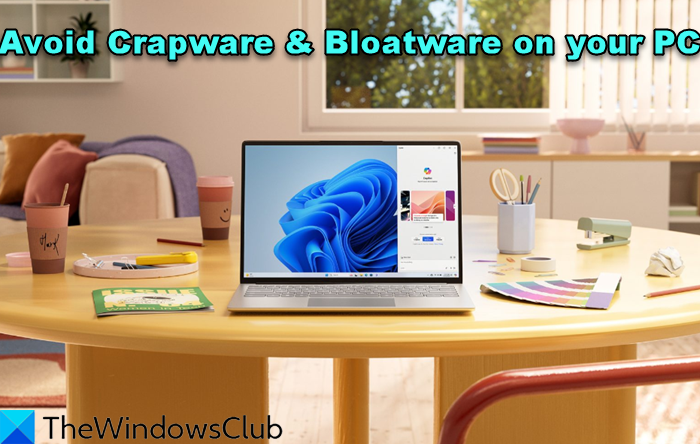Many people have excessive crapware and bloatware on their Windows 11/10 computers in different shapes and sizes, ranging from annoying toolbars to trial software versions. Usually, those people don’t know where and how all this unwanted software comes onto their computers. Unfortunately, crapware for Windows computers is common, and it’s a huge pain to uninstall most of it off your Windows PC.
Avoid Crapware & Bloatware on Windows PC

You might be able to get some bloatware off your computer, but there are even some pesky ones that hide from the Installed Programs list and refuse to get off your PC without a fight. That’s why learning how to keep your computer clean is essential for people who want to keep it running at maximum performance.
The most common and dangerous way of bloat transfer: Installers
Most installers nowadays offer “promoted software” as an option to install with your program. Internet toolbars are usually the “promoted software.” You’ve probably seen this called “Babylon Search” before, right? That deadly piece of software forces your homepage to be set to their search engine. It usually also comes with a toolbar, which most people don’t want.
Some of us have a bad habit of rapidly clicking “Next” through an installation. It would be best if you didn’t keep doing this because you don’t know what you accept. Lots of installers have a checkbox to confirm you want to install this along with it, but you most probably ignore those and continue. The thing is, those checkboxes are usually checked for you. Treat installers like contracts. Read everything carefully and accept what you want to accept.
The not-so-sneaky way: Fake download ads
You’ve probably seen these on sites often. They try to trick you into thinking you recently started a download, but fewer people fall for these than the installer trick. When you download the file they link to, you get unwanted software.
These ads tend to confuse people if they are placed on a download page, especially if that download page has lots of text. You can distinguish them by simply noticing that the formatting looks nothing like how the page is formatted—it’s not hard to distinguish between plain links and a huge green button with the words “FREE” surrounding it. However, if you want to make sure, hover over the big green button and see if the URL has the word “ads” in it.
Read: How to remove crapware from Windows
And… most importantly your computer manufacturer
If you have recently gotten a computer from a shop or online, there were most likely free CPU-hogging, RAM-sucking applications, trialware, and craplets bundled along with your purchase. People wonder why their computers are so slow without realizing that they have about 10 free antivirus software trials on their PCs, all running simultaneously. Your first instinct might have been to visit your friendly Control Panel and ask ‘it’ to do something about it. If you did experience this, your computer might have caused you a case of shock because of how tiny that scroll bar on the Program & Features applet looks!
The easier and more efficient way to fix the bloat problem would be taking out your Windows Installation disk stuffed at the bottom of your drawer, reformating your PC, and doing a clean install. Remember, this will only work if you have a Windows Installation disk from Microsoft, not the System Image your OEM PC supplier created. With that handy disk, you can clean and install Windows on your PC and use the Product Key labeled on the sticker on your computer. You don’t need to worry about using the CD’s license(s) because your manufacturer bought you one!
If you are unable to uninstall some crapware or toolbars via the Control Panel, maybe these Crapware Removal Software, Bloatware Removal Tools or Toolbar Removers can.
like the free pdf download on this page, good example lol
Yes :) Really difficult to control all such ads.
Foistware can be downright misleading too. Don’t be surprised if you see a Decline button which is meant to indicate that you were ‘declining to decline’ the toolbar that was offered.